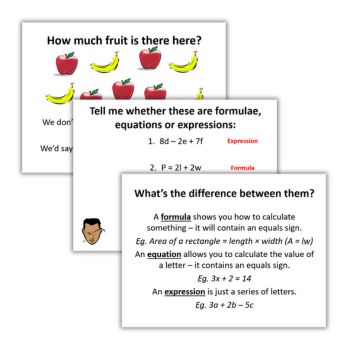This nine-lesson simplifying expressions PowerPoint takes students from the most basic simplifying up through substitution and proof of formulae.
The lessons focus on these questions. Can I:
- decide whether I have a formula, an equation or an expression?
- simplify expressions by joining ‘like terms’?
- substitute values into a formula?
- simplify expressions involving brackets?
- simplify algebraic fractions by finding a common denominator?
- simplify expressions by using the rules of indices?
- write a formula for a given situation?
- rearrange formulae by using inverse operations?
- show how a formula is formed?
What’s the difference?
A formula shows you how to calculate something – it will contain an equals sign.
Eg. Area of a rectangle = length × width (A = lw)
An equation allows you to calculate the value of a letter – it contains an equals sign.
Eg. 3x + 2 = 14
An expression is just a series of letters.
Eg. 3a + 2b – 5c
Learning objectives
- Decide whether something is an equation, expression or formula
- Substitute numbers into given formulae
- Multiply out brackets and simplify expressions
- Simplify simple algebraic fractions
- Simplify expressions using rules of indices
- Write a formula for a given situation
- Rearrange formulae by using inverse functions
- Use and show how formulae are derived
KS3 maths curriculum area
Algebra: Substitute numerical values into formulae and expressions, including scientific formulae
Andy Lutwyche is a purveyor of mathematics and a producer of resources, more of which you can find on his TES shop. You can also follow him on Twitter at @andylutwyche.














